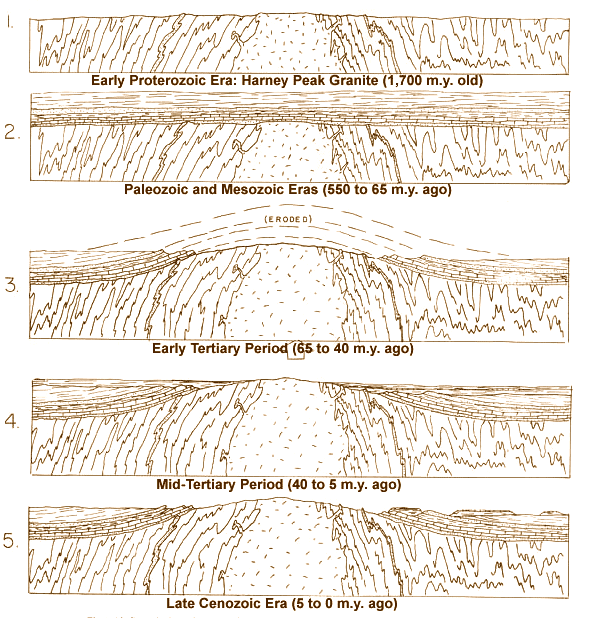
Cave Geology
The Black Hills region is home to some of the most unique and interesting caves in the world due to their age, evolutionary history, rare formations and complexity. All are precious natural gifts that we may enjoy today and must protect for future generations.
Sharing the common bonds of their origin, each is unique in its own way. Located in a band of limestone rock called the Pahasapa Limestone, the caves encircle the central granite core of the Black Hills. This limestone was created during the Mississippian Period, approximately 360 to 330 million years ago on the bottom of an ancient sea.
The present day caves were greatly affected by five events in the area’s geologic past.
First, the limestone rock was modified by a variety of chemical processes.
Second, an early cave and karst system developed in the young limestone rock.
Third, the limestone and early caves were buried by other layers of sedimentary rock. They laid dormant and preserved from approximately 320 million years ago until 60 million years ago.
Fourth, the central granite of the Black Hills was slowly pushed up from 60 to 40 million years ago. The long-dormant limestone was subjected to lifting, cracking and the slowly circulating, acidic groundwater. During this phase the dissolving process of cave building was renewed. It was during this era that the caves as we now know them developed.
Fifth, periodic episodes of flooding and draining further modified the caves until a long-term lowering of the water table caused them to drain. Before and after they drained, the speleothems (decorative cave formations) were deposited above and below the water table.
These processes and events set the stage for the caves that we see today. All are located in the Pahasapa Limestone outcrop belt. Most orient themselves along lines that radiate outward from the central Black Hills. Like the spokes of a wheel, these cracks developed in the limestone as it was lifted. A case in point is Rushmore Cave. Located due east of Black Elk Peak (the approximate center of the Black Hills), its passages run in an east-west line. Circling the region like the numbers on the face of a clock, the cave passages orient themselves like the hand of a clock – with the predominate and most numerous passages – pointing toward and aligning with a line radiating from the central Black Hills region.
Generally speaking, caves are a young and short-lived geological phenomenon. The very solutional and erosional processes that create them will eventually destroy them. Therefore their age is usually in mere millions and tens of millions of years. The Black Hills region is an exception. Many area caves intersect and contain portions of the 320+ million year old Mississippian cave systems, and there is evidence that the present day cracking planes were partially inherited from older rock structures. The most recent era of cave development started about 60 million years ago , making them old even by geologic standards. Part of the reason that these caves are so old is that the rock (pahasapa limestone) is sandwiched between other layers of sedimentary rock and thus partially protected from the forces of erosion.

Sharing this common ancestry and a variety of inherited traits, local geological conditions has caused each to be uniquely different! Some are three dimensional rectilinear mazes containing many miles, possibly hundreds of miles of passages, compacted beneath a relatively few square miles of surface land. Others are small and localized. Some contain walls and ceiling coated with calcite crystals of stunning beauty. Many contain the familiar dripstone formations such as stalactites, stalagmites and flowstone. While others host rare formations such as boxwork, aragonite and helictites.
Our knowledge of caves is far from complete. Ongoing exploration and research continues to expand our understanding of this mysterious underground world. Some consider it an “underground wilderness” – a new frontier to be explored and understood. It is also a very fragile environment that we must protect and preserve for future generations. Please treat all caves with the respect worthy of an ancient and treasured resource that can never be replaced.
